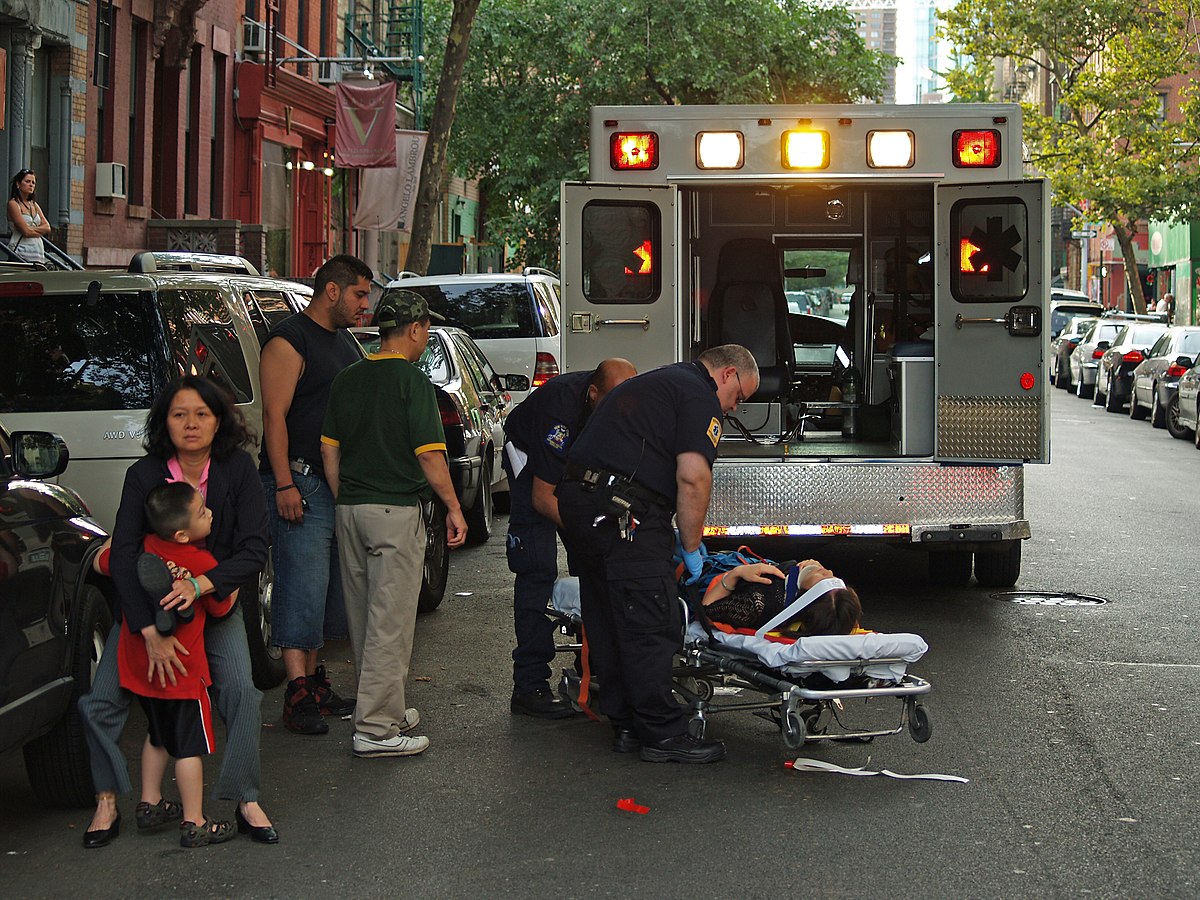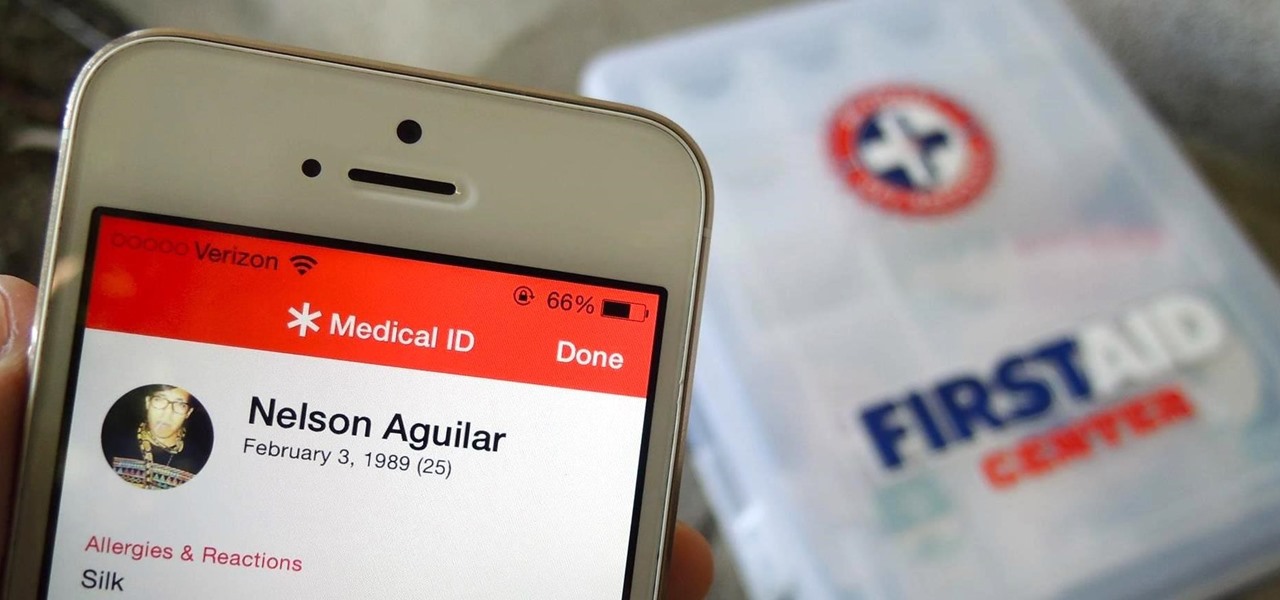PREPPER: Homesteading or Prepping with Very Little Money
THE LATEST FROM THE PREPPER WORLD
I’ll readily admit it; I’m a prepper, survivalist, homesteader, or whatever the current term is for someone who wants to be sure in an emergency that I can take care of myself and family. That to me is much better than standing by wringing my hands in the hope that FEMA can get to me with provisions before I (or worse yet– my husband, children, or grandchildren) starve to death.
The Words “Prepper” or “Survivalist”
I know for some of you, the words “prepper” or “survivalist” may bring visions of Doomsday Preppers with the fall-out shelters, bug out buses complete with goats trained to load up on command, discussions of polar shifts, rogue planets, and zombie apocalypses. Well, maybe I’m not in that group. However, I can see possibilities of needing more than a few days, weeks, or months of ability to live off of my food stores and be totally self-reliant.Many Things That Can Go Wrong
I’m of the mind that there are many things that can go wrong. These range from several day power outages, auto accidents that require long hospital stays and multiple surgeries, an unusually cold winter complete with 4’ of snow and frigid temperatures for weeks at a time (winter of 2016/2017 here), to loss of a job, a nasty flu epidemic where you need to stay home to keep yourself and your family safe, and even up to an EMP missile shot at us from a hostile government. There are many things that can go wrong. So, a little preparation can go a long way to keep you calm, comfortable, and secure.Lot of Month Left Over at the End of the Money
Some of you may be thinking that you would love to prepare for hard times, but there is just a whole lot of month left over at the end of the money. Many of us can certainly identify with that.My Journey of Prepping
I really began my journey of prepping when I was unemployed, and getting an unemployment check that covered my mortgage, utilities that had been discounted because I was on unemployment, the few bills I had which were also discounted. The rest went to feed the chickens, rabbits, cats, and dog with none left over. If my mom needed help with her garden or anything, she had to pay for my gas. Otherwise, I stayed home.Fortunately, I did have a lot of food in my pantry. Some of it was home canned. Much of it was dried ***beans***amazon.com/Augason-Farms-Emergency-Storage-Servings/dp/B0754PLKSX, ***rice***amazon.com/Lundberg-Family-Farms-Eco-Farmed-25-Pound/dp/B007W6B72U, and that sort of stuff. Although I had quite a bit, eventually that ran out.
Food Closet
As time went on and the need increased, I swallowed my pride and found a food closet. I drove out to it and while waiting to register for the first time, I noted that the people who were already registered could just come up and get their groceries. Many came and left with bags of breads, sweet rolls, donuts, cookies, and the like. I sat, pretty sure there was nothing I could eat in their food closet, as I am allergic to wheat.When I finally got registered and it was my turn to get groceries, I told the ladies who were working there I was not sure they could help me due to my wheat allergy. So they asked me what I would like, and I asked for stuff like dried beans and rice and the type of stuff I could make real meals out of. You should have seen the sparkle in their eyes! I was next asked if I only liked white rice. I told them I’d take whatever, but my preference was for brown rice.
Bags of Food that Lasted
Next thing I know they have filled up five huge, heavy bags of food for me. I told them it was just me at home, but they said no one else wanted this type of stuff, and since I did they gave me a lot. It lasted me until after I finally found a job and the three extra weeks while I was waiting for my first pay check. I even had a bunch left over!One Second After
It was during that time of unemployment that I read the book ***One Second After***amazon.com/Second-After-John-Matherson-Novel/dp/0765356864 by William Forstechen. It is about a little town in North Carolina after an EMP took down the electrical grid. Being in the middle of my own SHTF situation (unemployment and quickly running out of food), I made a firm resolution to be sure I could take care of myself and hopefully my family as well should a more long-term situation happen, like the EMP in the book.Surviving and Food Storage
Being unemployed, I had more time than money, so I used it to learn everything I could about surviving and food storage. For example, I learned that the Church of Jesus Christ, Latter Day Saints (LDS) recommends that everyone have at least one year of emergency food. They recommend, as emergency rations:- 400 lbs. of Grain (300 lbs. wheat and/or rice, 100 lbs. oats),
- 60 lbs. of Legumes,
- 16 lbs. of Powdered Milk,
- 10 Qts of Oil,
- 60 lbs. of Sugar or Honey, and
- 8 lbs. of Salt.
Daily Ration Per Person
Wow! That sounds like a lot of food, but what does that break down to on a daily basis? When I broke down the years’ worth of food into weeks and then days, the daily ration per person worked out to one cup of wheat (or rice), ¾ cup of oats, 1/3 cup beans, 2 TBL oil, 1 glass milk (2 TBL powdered milk with 8 oz. of water), and 1/3 cup of sugar. That is the amount for the whole day and just doesn’t seem like a lot of food, especially for men and teens.Actually, it is a little better than it looks. That one cup of wheat, soaked and cooked becomes 3 cups or 1-1/2 cups of flour, if ground. The oats roughly double in amount as does the beans, when soaked and cooked. This ration of food would keep you alive. It would not be gourmet. It would likely not be something you would enjoy for very long, but you would survive (unless like me, you are allergic to wheat).
My Home
My home was at the top of a steep, thickly treed mountain. Northern California has a high fire danger in the summer. Should a fire threaten, I might have only minutes to evacuate. To facilitate the evacuation, I kept all my camping and survival gear and cat carriers in the garage, all together, on the left and right by the door. That way I could quickly load everything into my vehicle without worrying I might have left something vital. I also had one container in the house that I kept all my important papers in (such as passport, birth certificates, and insurance papers, and the baby pictures of the kids), all kept in the same place that I could just grab and load up as well and be out of there in minutes.Five-Gallon Buckets and 10-Gallon Barrels
In order to do that, I had several ***five-gallon buckets***amazon.com/Gallon-White-Bucket-Lid-Durable/dp/B06XHFTH7N with handles, each numbered, and each of which contained one weeks’ worth of survival rations, along with spices, a roll of toilet paper and some personal care items, and a list in each bucket of what it contained, along with a master list of what was in each of the other buckets, so if I needed something that was not in that bucket, I could locate it. I also had a bucket that contained a week’s worth of survival rations for the dogs and cats. A bit later, my son and two grandsons moved in with me, so I changed those 5-gallon buckets to ***10-gallon barrels***amazon.com/Winco-FCW-10-10-Gallon-Polypropylene-Container/dp/B01JLKPGDU with handles. Each barrel had one weeks’ worth of food for four people, based on the LDS recommendations. Once I was employed, I scrimped and used every spare nickel for long-term food preps.Ways to Put Emergency Food and Supplies Away
So now that you know my story, let’s find ways for someone (maybe like you), who has lots of month at the end of the money to put some emergency food and supplies away, just in case.Dried Food With Long Storage Life
The first thing I did was to get as much dried food with long storage life as I could afford. For that, I visited the feed store. Yes, you read it correctly, the feed store. There are 50 lb. bags of wheat, corn, and oat groats, inexpensively available. Yes, you will likely have to clean that grain a little more than you would have for stuff that you buy at a grocery store. However, at less than 1/3 the price, it seems a small sacrifice for a lot of food. At those prices, you could have a year’s worth of survival rations of grains for next to nothing. And while that is not gourmet meals, it is survival and security. Once I had a three-month supply, 6 months, and thenb a years supply of the essentials for myself, children, and grandchildren, I took a few moments to celebrate and feel great about my accomplishment and the emotional security it brought me.SOURCE
13 Weird Survival Tools Every Prepper Should Stockpile
Having the right survival tools is an important part of survival. One of the major things that make mankind stand out from the rest of the animal kingdom is our ability to create and use those tools. Ever since the first caveman picked up a stick to hit his obnoxious neighbor, we’ve been finding ways of using the materials around us to do things that we can’t do with our bodies alone. As time has gone on, the number, variety and complexity of those tools has increased exponentially.Forty-some years ago, when I got my start in survival, we didn’t have the vast array of gadgets and tools that are available to the survivalists and preppers of today. Rather, we had to make do with what we could find, whether in the supermarket or the hardware store. Many of these tools are still worth using today, either because they are more cost effective or work better than the newest and hottest survival gadgets.
#1. Folding Pruning Saw
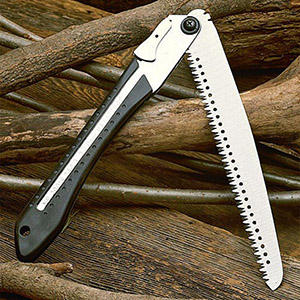
The only “survival saw” we had back then was the wire saw. If you looked hard enough, you could find a three-stranded one, which meant that if one strand broke, you could still cut. But wire saws have never been very efficient tools. The newer chain saws are much better.
But long before the handheld chain saws came along, I found a fantastic solution. That’s a folding pruning saw. It’s made for cutting wood, fairly compact and lightweight, and with the blade folded closed, it’s safe to carry. And using a folding pruning saw will give you a much more accurate cut than you can ever expect to get out of a chain saw. If you’re making something and not just cutting off a branch to use as a ridge pole, that could be important.
#2. Wasp Spray

I travel into Mexico regularly, where I’m not allowed to carry a firearm. So I have to make do with other weapons. I carry a knife and even have a cane sword, but both of those are limited to my arm’s reach. For something with greater range, I keep a can of wasp spray in my car. That will shoot about 20 feet, and is just about as effective as pepper spray at incapacitating an assailant.
#3. Can Opener
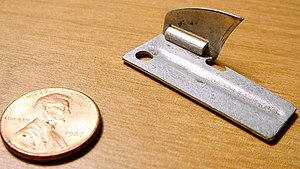
P-38 Can Opener
Back in the days of military C-rations, the Army issued the P-38 can opener. This compact can opener was essential if you were going to make use of those C-rats. Fortunately, they had a hole in them, so you could hang it on your dog tag chain or put it on your key ring. I’ve been carrying one there since basic training, 40 years ago.
#4. Machete
The machete has never gotten the credit it deserves here in the United States. We prefer other tools. But if you want something you can use to cut wood, clear a path and a host of other useful things, the machete is it. Besides, it makes a fearsome weapon in close quarters. A good machete should be part of everyone’s bug out bag.#5. Plastic Tubing
Gasoline is useful for many things, not just keeping our cars running. In a post-disaster world, we will need it for lawn mowers, chain saws and other power tools. It also makes a great fire starter, especially when trying to start a fire with wet wood.With gas stations shut down, few people are going to be able to get their hands on much gasoline, making it a valuable commodity. But there will probably be lots of cars sitting around with gas in the tanks. All it takes is a piece of flexible vinyl tubing, small enough to get through the “unleaded only” hole in the filler neck and you can siphon that gas out of the tank.
#6. Pry Bar
Speaking of scavenging; gasoline isn’t the only thing you’re going to be wanting to scavenge at that time. If there are abandoned buildings around, people will be breaking in, trying to scavenge anything they can to survive. But you’ll need something you can use to get in; like a big pry bar.Let me mention here that the difference between looting and scavenging is that looting is about getting things you want, while scavenging is about getting things you need to have in order to survive. Always make sure that you only scavenge from abandoned buildings, as stealing from someone’s home could end up resulting in them dying from not having what you have taken.
#7. Sanitary Napkins
First-aid is an important part of survival, especially first-aid for major wounds. This can mean soaking up a lot of blood quickly, which is exactly what sanitary napkins were invented for. They make great bandages, in addition to being useful for their original purpose.#8. 0000 Steel Wool

Speaking of starting fires, one of my favorite fire starting tricks involves the use of steel wool. But not just any steel wool will work. You need the finest of the fine, 0000 steel wool. This can be purchased in the paint department of your local home improvement center, where it is used for fine finishing of varnished and lacquered wood.
To use the steel wool as a fire starter, break off a chunk and expand the fibers, making it look kind of like cobwebs. Then take it and brush it across both poles of a 9 volt battery. The spark this causes will start the steel wool burning.
#9. Duct Tape
Speaking of things you can find in the hardware store, make sure you have a goodly supply of duct tape on hand. This can be used for a myriad of repairs, including getting more miles out of a tire. I remember once when I was traveling and had a trailer tire that was wearing through the nylon belts (this was pre-steel belted tires). I was able to make it 50 miles to the next town by adding layers of duct tape over the bad spot on the tire.Related: 26 Practical Survival Uses for Duct Tape
#10. Zip Ties
Zip ties are the electrician’s version of duct tape. Sometimes referred to as “wire ties” these are designed for bundling wires together. However, they are an excellent way of tying just about anything together that you need to. I’ve build lean-tos and other shelters in the wild, using nothing but zip ties to hold the pieces together. Just make sure you stock a variety of sizes, as different sizes are useful for different things.#11. Dental Floss
Dental floss is another highly useful material, that we can use for a lot of different purposes. One of the best uses of dental floss in a survival situation is for fishing line. But it can also be used in first-aid, and for a number of different places where you need cordage. Just as I used zip ties to build a shelter, you could use dental floss as well. It is tough, and the waxed type is waterproof. It even comes with a cutter, as part of the package.Dental floss can also be useful for making snares. Most snares need a tripwire of some sort and dental floss works well for that. But it can also be used to tie the pieces together. Being smaller than paracord, it works better for tying small sticks together.
#12. Guitar Strings
Speaking of snares, one of the best materials for making snares is metal guitar strings. They already have a small loop at one end, allowing you to slip the loose end through that loop and make a larger loop. Thin and tough, they are highly resilient, allowing you to use them over and over again.
 #13. Pencil Sharpener
#13. Pencil Sharpener
Sometimes it can be hard to find tinder for a fire. But without
tinder, many fire starting methods will leave you cold. This problem is
even worse in wet weather, as many of the things we would normally use
as tinder will be wet too. A simple pencil sharpener can solve this
problem, allowing you to cut shavings from sticks.Surviving The Purge In Real Life: What Happens When Laws Stop?
For one night, laws do not exist. Would you survive?
The Purge – it is a concept where laws stop being enforced and the crazies of the world let loose and do whatever they want without consequence. But it has happened before, and it was exactly what you expect, murder, chaos, and complete anarchy, as society saw the worst in people.If you haven’t heard of The Purge, it is a popular film series wherein for one night of the year people can do whatever they want without the restriction of rules or laws. Basically, for 12 hours, anything goes, and is supported by the government due to crime rates dropping, population control and revenue from weapons and security.
But what if the purge happened in real life? Well, it did. In Espirito Santo, Brazil, where police went on strike and the murder rate climbed by 650% in just three days.
The Brazil Purge: Three days of anarchy
For me, I always like to think that in tough times, people would work together to pull through. I have seen this happen in natural disaster cleanups and flood recovery efforts, where communities have banded together to volunteer and help clean up, repair, and share supplies. But that’s not all true, and the Brazil Purge was a reflection of the chaotic morals that some can people possess.When police in the State of Espirito Santo took a six-day strike over work conditions and wages in February 2017, it was a sign to many that people could do whatever they wanted to with no repercussions whatsoever.
In one city alone, just after a few days, there were a reported 52 murders, thousands of cases of rape, theft, shops being robbed, vehicles being torched and people fighting with guns and machetes on the streets attacking and killing whoever they please. It was an awful scene not only for Brazil but for humanity.

As a response to the lawlessness and chaos, the Brazilian military stormed the streets to retake control from the ungrouped criminals and restore order and discipline.
To survive the Brazil Purge, many locals stayed in their homes during the entire ordeal. They boarded up their windows, kept all lights off, and sat armed with whatever they had in their house listening to the screams and gunshots in the streets outside. One of the locals said that things were “absolutely crazy” and that there were “people running around with guns in pretty populated areas, dozens of people stealing from malls, even dead bodies on streets”.
Because of the complete lawlessness, schools, parks, and health services closed. This meant that there was no way any injuries, medical treatments or vaccinations for a yellow fever outbreak which Espirito Santo residents were battling with.
This goes to show that if the purge really did happen, there would be much more at stake than just violence and disorder, as services have to close down. Hospitals, food supply lines and other necessities that we need every day would have to shut down due to security concerns, which would cripple a city, state, or country, months after social order has been regained.
Where did the Purge come from?

The idea of the Purge isn’t new. In fact, the idea of the Purge comes from the concept of two different ancient traditions that had lawlessness and social disorder as their overarching themes.
Saturnalia – The first tradition was the Roman festival Saturnalia. The festival was a week-long carnival that allowed illegal activities, as well as role reversals where the servants of that time were served by their masters. During the festival, not only were ritualistic sacrifices made to gods, but it was also a holiday from all forms of work. This meant that schools were closed, courts were not open, and no enforcement of rules was able to be carried out.
The role reversal side of the festival enabled slaves to mistreat their masters which I am sure many servants enjoyed the experience of. Every slave had the utmost freedom to do and say whatever they wanted. This kept with the overall theme of the festival, which was to turn the current world upside down and cause chaos by reversing everyday norms and practices.
Krypteia – Another tradition, which I believe has more of a similarity to the Purge’s theme, is the Krypteia tradition of Spartans. Specially chosen Spartan men who had excelled in their training were instructed to go out into the Helot countryside and surrounding villages and kill any person they wanted and take any food they pleased. The tradition’s reasoning was to prevent the threat of rebellion and to keep the Helot population in control.
If these pre-18th Century festival were to be revived today, we would ultimately see something similar to the Purge happen and a recreation of the Brazil Purge. But what if the purge was real? Let’s take a look at what would happen.
What if the purge was real?

As far as the film series goes, ‘The Purge’ is a fictitious ‘civic tradition’ embedded in America’s constitution by a political party that goes by the name of “The New Founding Fathers of America”. Their rise to power was during a financial collapse where poverty, crime, and national debt was at its highest. In the films, the Purge is a tradition that benefits the nation’s health by greatly decreasing crime rates, unemployment, a strong economy through the purchase of weapons and home security, and population control.
Now don’t forget, this is only a movie. But what if the purge was real? While Brazil’s Purge was unorganized and started without much notice, the purge in real life would be quite different and as an organized and calendered event, is something that would allow for more preparation and leadup.
What would happen before the purge?
If the purge was to happen, in the buildup before it people would stock up on supplies and protection. This was one of the resounding factors that the film hit on with the purge’s economic success – gun sales and home security purchases would go through the roof in the weeks and months ahead of the event. I have no doubt that preppers would have already stockpiled what they need well ahead of an event such as this, and would be the best prepared to keep their family safe.
Businesses – I imagine businesses would need the most preparation for a purge event. While violence on the streets is one of the biggest issues, looting and theft would come in at a very close second, as all laws are removed. This means that if you are a shop owner, you would have to consider using high-impact proof and bulletproof windows with exterior sheeting protection.
Governments would also have a responsibility to safeguard banks. In a world without rules or laws, while most of the criminals are committing violent crimes, the more organized criminals will be targeting financial institutions in an attempt to make a high monetary gain in their 12-hour lawless window.
Community meetings – While businesses and government buildings will be focussing on their structural protection and defenses, community organizations will group together to have a plan of attack in regards to what they will be doing during the purge. The film shows that most people have a hidden agenda and that their true inner-criminal nature comes out during the purge, I believe that a higher amount of people have decent morals and would rather stay safe than to be on the streets looking for potential victims.
The community meetings would no doubt focus on the concern of safety for those who are more vulnerable in society. This includes the elderly (retirement centers and elderly living on their own), children and animals.
Bugging out – If there were to be an event like this, there will be mass traffic jams of people leaving city areas, looking to escape to the wilderness or safe country areas with few, or no other, people around. There is no doubt that the worst possible place you could be in during a societal breakdown or a purge would be an urban or city environment. The more people there are around you, the more likely you are to be the victim of a criminal.

As with all rules of bugging out of an event, leaving early is the wisest decision. Packing the car and driving out of the city just before a purge starts will leave you stuck in thick, congested traffic surrounded by hundreds, if not thousands, of anxious and stressed people looking to protect themselves and their families in a lawless world. Instead, planning a much earlier departure would be a safer bet.
Where would the best place be to bug out of a purge? Out of the country, of course. If a purge is only country-wide, that means the lawlessness only applies to that area. Ideally, situating yourself in an embassy or international airport would afford you the protection of international, not domestic laws. However, as social chaos ensues, I’d much prefer to be out of the country, or at least out of a busy area.
Now while these are some of the preparations to keep yourself safe, or your business secure, in a possible purge, there will also be meticulous planning and preparation done by the people who would benefit the most out of it – the criminals and gangs. Most organized crime syndicates and gangs would have predetermined spots they would hit, whether they would be opposing gang-owned territories, common enemies, or financial institutions.
What would happen during the purge if it was real?
The streets would be quiet for the most part. There are, of course, areas where it would be busier. Most of the busy areas would be ones where we already see much of the violence on the news, such as gang member-dominant areas and low-socioeconomic regions. The violence (statistically already high) would just increase in those areas.For more wealthier neighborhoods, families would instead focus on staying indoors and safe, rather than risking their lives on the street for the sake of being a criminal. If the purge was real the choice would be simple, if you want to be a criminal you would put yourself at risk of being killed by another criminal. If you want to stay safe, staying in a secure home, or bugging out, would greatly increase your chances of survival rather than getting involved in a gunfight.
What about after the purge?
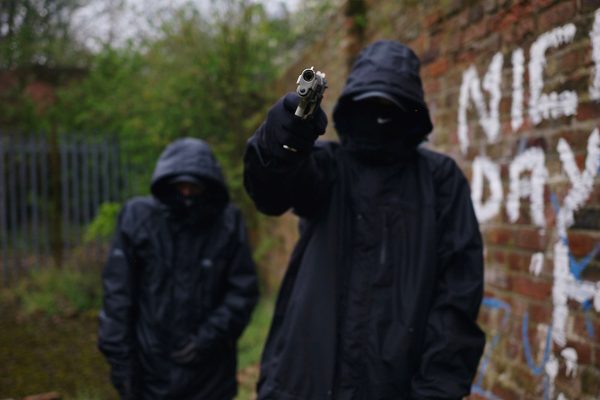
While the purging in the franchise films works well as people slip back into their normal, non-criminal mindset and claims it helps the nation, in reality, this would not be the case for people or society.
For people in the purge – For the people that have participated in the purge, it is not just a paintball game where you put down your gun at the ring of a timer. If your family or friends have been killed by someone there is a natural tendency to seek revenge and continue the fight, whether it is legal or not. This is definitely the case for gangs who are at war with each other. There is no peace treaty at the sound of the horn. Instead, they will most likely continue warring on well and truly after a purge has finished.
For the more civil individuals that participated in the purge, there would be no trust in a community for them. In a true lawless society, we would see some people change and become deviants, anarchists and sadistic as their true inner-nature is revealed. The same applies to the concept of the purge. Those nice neighbors of yours might be true inner criminals, and after seeing that, how could you, or anyone else in a community, accept those people knowing full well that they cannot be trusted at all?
For businesses – I imagine no matter what precautions a lot of businesses take, nothing can withstand a truck driving through the front door allowing the complete looting of the business. During natural disasters and protests, damaged stores would generally be able to claim much of the damage and stolen or missing contents through their business insurance, however with the purge, insurance agencies would either have a clause rendering purge-related claims invalid, or many insurance agencies would go bankrupt with the number of claims they would have to pay out.
For emergency services and medical facilities – Medical admissions is where the aftermath of the purge would be felt the most, as people start checking themselves in with gunshot wounds, knife wounds and other things resulting from the night before’s activities. This would create an immense over-demand on the medical system with the country’s hospitals not having enough space, staff, or supplies to cater for all of the injuries and casualties a purge has caused.
Financial – While the film’s purge was formed as a way to boost the country’s economy, in fact, a 12-hour purge would likely cripple the economy. Trucks would stop driving, supplies would stop moving and trading, and systems would stop functioning as workers would all be pent up in their homes waiting for the criminals to have their free-roam period. Then, as the country resumes trading, it would be slapped with an enormous bill as the country goes into recovery crisis mode with emergency services dealing with the cleanup, public works repairing public property, and businesses out of operation leaving a high rate of unemployment. This would cripple a country’s services, economy and productivity rate and a reason why a purge would never happen.
How would you survive the purge?

Okay, so let’s face it, whatever government is present, there will never be such a system as the purge. It just won’t happen. But that’s not saying that something similar can’t happen, as we saw in Brazil. Instead, what is more likely to happen is lawlessness during a crisis. So how would you survive a purge scenario? Here’s some simple tips.
Don’t be there – No matter what the circumstance, get out of dodge and go somewhere safe and well ahead of time. Doing this early ensures that you don’t get caught in the congested traffic with everyone else getting out, or that you are blocked by criminals eager to start early. Instead, leave at least a few days, if not a week, early and have the supplies to last you an extended amount of time longer than just the set period.
If you have no option but to stay during a purge or chaotic society, there are some things you can do to increase your chances of survival.
Stay indoors – In an event where criminals are in the streets doing whatever they want, your best bet of survival is to hide and stay indoors. The priority is to make sure your home is secure, but not so secure that you have high fences, barbed wire and security cameras all the way around, as that just creates more of an incentive for criminals to see what is behind all of that security. Instead, using more ‘grey man’ home security techniques, as well as reinforcing any entry points to your home from the inside will work as a much more efficient type of security.
Hide even further – If you have a hidden attic, basement, or a wardrobe that is hard to find, hide in that. Having that extra level of invisibility when criminals are doing a quick search of your house could be enough for them to conduct a search and deem the house as clear.
Have something to defend with – If it’s a person carrying a weapon, you can’t fight it barehanded. Simple home defense items are kitchen instruments or garage tools that are able to cut or bludgeon an intruder.
Stay away from the safe places – If you have to leave the home, don’t go to a place you think would be safe. Essentially, safe places such as shelters, schools, police stations and food halls will be fishing nets for criminals waiting for desperate people to come. The best idea is to avoid any type of public place or place where people gather, altogether. Instead, move further out of town or away from central areas and stick to the back roads and quieter areas.
Would you survive the purge?
If a purge was to happen in the country, it would signify to me that it’s time to buy a one-way ticket and leave that place until the government sorts itself out. Thankfully, we can all remain assured that an event such as the purge is only going to stay in the movies.But as we have seen in the Brazil Purge, similar scenarios can, and do, happen. So if the purge was real, do you think you would survive?
Food In Your Vehicle – What’s Best For 72 Hour Survival Kit?
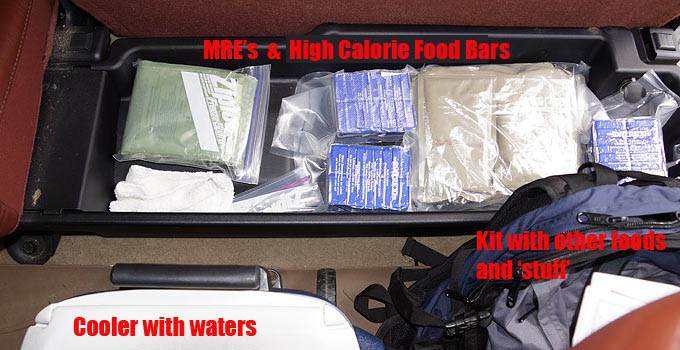
Do you keep any ‘survival’ food in your vehicle?
Is it more than just a few snacks for while on the road?
I’ve posted a number of articles on 72-hour kits to be kept in one’s vehicle along with suggestions for items that you might include.
One important item is food.
There are some hypothetical scenarios whereby you might not have the luxury of stopping at a fast food joint, grocery store, or other establishment to get some food. And it’s good to consider this for preparedness while on the road.
I do keep a variety of foods in my truck as part of my 72-hour kit. I also rotate this food during the year to avoid spoilage.
It’s especially important to rotate given the summer heat that can build up inside the vehicle which greatly reduces it’s shelf life.
With that in mind, let’s think about what specific foods or types of emergency food might be better suited for keeping in your vehicle.
– Snacks
– Calories
– Balance
Snack Food In Your Vehicle
This is what you will likely semi-regularly dip into. A quick little snack.For this purpose I keep a handful of ordinary food bars of various flavors, brands, and variety.
I keep them in a Gallon size Ziploc bag which I store in the center console. They’re out of direct sun that way. Although they still get good and warm during the summer, I do rotate them indoors after awhile.
Note: The soft gooey type food bars will melt in the heat. To avoid this you might focus on the granola type (harder) bars.
Note: Food bars will run anywhere from 100 calories to several hundred each.
Calorie Foods In Your Vehicle 72-hour kit
While you will be much less likely to actually consume these (reserved for actual emergency or SHTF or bugout), you should consider counting enough calories for 3 days (general rule of thumb).That’s potentially a lot. You’re looking at 2,000 calories per day.
So how are we going to come up with enough food that will actually fit somewhere in the vehicle without getting in the way?
I’ll tell you what I do…
I keep an assortment of MRE’s, specific high calorie food bars, some cans of chicken, even some peanut butter which is very high in calories (energy food!). Can opener, fork & spoon too.
3,600 calories x 3
Datrex 3600 Emergency Food Bar -CASE OF 3
(Review)
More: MRE Meals for Food Storage & Survival Kit
Balance of Food
Pay attention to the calories so you have enough.Also go with some variety and balance. Maybe some sweets too (a quick boost).
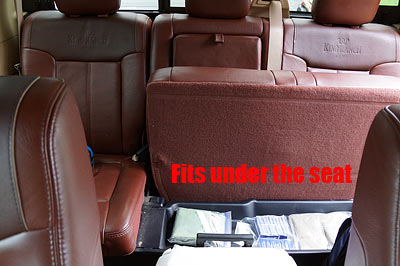
Where to store the food in your vehicle
This can be tricky. A smaller vehicle has less room than a big truck (for example). Be creative. Nooks and cavities here and there? Use them!I keep a backpack in the truck with some of my other emergency kit supplies (and some more food). I simply keep it on the floor in the back seat. You could use the trunk.
Tip: My water (except during the winter) is kept in a cooler on the floor in the back. Surprisingly the water bottles don’t get hot in there.
Teaching Your Children to be Prepared in Case of Emergencies
When an emergency strikes, you may know what needs to be done. Perhaps you need to get to a safe location; maybe you need to gather supplies and find a central location in the home. You may even need to start hoarding water and finding flashlights, batteries or a radio.Do your children know what they need to do? In the event of an emergency we, as adults, have a checklist in our heads of actions that need to be taken. Our children are on that list, of course, making sure they are safe. However, sometimes an emergency situation may prevent us from getting to our children.
This article will explain the importance of teaching your children to be prepared in case of emergencies. There are certain things you should do for your children. However, there are things they can do or should do depending on the emergency as well. Having children that are prepared will aid in the safety of the entire family.
What Ages Should Children Start Learning About Emergency Preparedness
Children are smarter than we give them credit for a lot of the time. Science has discovered that languages, understanding, and memory are best developed before the age of five. However, comprehension and formulating ideas are best developed between three and eight years of age.So when is the best time to start teaching your children about emergency preparedness? The sooner, the better. You can begin as soon as your child is able to start doing for themselves. If they are walking, talking and learning about their environment, you can start.
The younger you begin isn’t always the best thing though. Comprehension needs also to be established and age-appropriate tasks should be the main concentration until the child is old enough to develop their own plans and help you plan yours.
By the age of five, the child should be able to tell you the parents full names and your home address. Along with a contact phone number this basic information will aid authorities in helping to locate family members in the event of separation or being lost.
As the child gets older, their responsibilities can grow, and they can soon become an active member of the planning and emergency preparedness plans. The more the child is involved, the more likely they are to retain the information and use it when it is needed.
Ultimately, the safety of the family and the child is the adult’s responsibility. However, if the child can aid in their rescue or safety, then it will go a lot smoother and faster.
What Are Emergencies?
An emergency as far as a child is concerned can be extended further than that of an adult. For example, being separated in a store, as an adult, isn’t as big of a concern as it is with a small child.Anything that can happen or at home can be an emergency. Fire, flood, or natural disasters are all emergencies, regardless of age. However, smaller things such as broken windows, wild animals, or even a neighbors dog that has broken free of confinement can be construed as an emergency.
Any situation that can put the child at risk should be considered an emergency, and this list may take some time and thought on your part to compile. The most common and needing of emergency actions will always be the standard natural disasters or home invasions.
Evacuation Plans
The most important portion of any emergency plan is the evacuation route. You should make sure your child understands what an emergency is and then knows how to get out of the home in the event an emergency happens.You should create a drawing of your home’s floor plan with your child and have them locate all the possible entrances and exits. These should include doors and windows. However just as important as knowing where the exits are located is how to get to them.
Using the drawing you can block off access to various doors and windows and ask the child to find a route out of the house that avoids the emergency. Once the child has a mastery of how to get out of the house, they should know where in the neighborhood to meet the rest of the family.
There should be one location that the entire family agrees to meet at in the event a home evacuation is required. This could be a neighbors house, another family members home, or even the yard across the street.
Once the location is established, and the child knows where the actual, physical location is, the plan should be practiced.
You can create an emergency and have the family practice the evacuation plan. Make sure everyone knows how to get out of the house while avoiding the danger and that everyone meets up at the predetermined meeting location.
Practicing the execution of the evacuation plan is important to keep the plan fresh in the child’s mind. At a minimum of once a month, the evacuation plan should be practiced, more often if you think it is needed.
You should also, when the child is old enough, practice the evacuation plan during the late night hours after the child has gone to bed.
Because emergencies can happen at any hour, the child should be able to navigate the home, avoid the danger and get to the meeting location even if woken from sleep.
Knowing Who To Call
Sometimes emergencies happen when the child is alone. Especially school-aged children that may be home from school before anyone else is home.In the event of an emergency, the child should first ensure that they make it to safety. Either following the home evacuation plan or removing themselves from the emergency. Once they are out of harm’s way, they should know who to call and report the emergency too.
The first call should always be to emergency response. Calling 9-1-1 to report the emergency should be the first call. Emergency dispatchers will be able to assist the child with further instructions, ensuring they are safe and will stay on the phone with them until authorities arrive on the scene.
The parents also need to be notified, or a responsible adult that the child is familiar with. This can be a grandparent, aunt or uncle or even a neighbor.
Having phone numbers memorized is something that is going out of fashion with the growing popularity of mobile devices, online address books and similar. However, you should ensure that your child can reach you by phone in the event of an emergency that removes them from all mobile devices.
A cell phone number, work number or home number, along with 9-1-1, should be memorized by the child.
Pertinent Information To Know
Knowing the emergency contact number and how to get a hold of emergency services is crucial. However, the child should also know other personal information that may not be readily known, depending on the age of the child.Not all emergencies involve flooding or fires. Sometimes the child can become lost or separated from the family. In these type of emergencies, the child should know specific personal information about the parents and the home.
At a minimum, the child should be able to give mom and or dad’s full name. Because children call their parents “mom” and “dad,” when asked by a police officer or other adult who may have found the missing child, they should be able to tell the adult the full name of their parents.
Knowing an actual name will help in locating the parents of the missing child.
If the emergency happens outside the home and the parents aren’t around, the child should also be able to tell authorities their home address. At a minimum, they should know the house number and street name. This will help police return the child to the home.
In Conclusion
Emergencies happen. From fires, flooding, natural disasters to being separated from the parents. Children should be prepared to assist and handle any situation that can come up.Giving your child the knowledge of emergencies and the tools to be prepared is crucial. They should be armed with a memory of contact information, and at a bare minimum how to use 9-1-1 to get a hold of emergency responders.
Because emergencies can happen in the home and will be the most encountered emergency for a smaller child, an emergency evacuation plan should be drawn up, studied and practiced. Once the child is familiar with the procedures, meeting locations and how to get out of the home and to a safe meeting place, everyone involved will feel more prepared to handle an emergency.
While it is near impossible to tell how any individual will react to an emergency situation, giving children the tools to use in the event of such issues will go a long way to making them feel safe and get safe when it is needed.
Survival Tools You Can Make Out Of Scrap
 You
have planned well. There’s the emergency kit in the corner, along with
your survival backpack, where necessary supplies that can last you for
at least a week take up most of the space. You’ve learned basic skills
to help you when disaster strikes – how to forage for food, look for
water, build a fire from scratch, and all the other tricks. However, how
about improvising some survival tools from scrap, do you have the
knowledge to perform this task?
You
have planned well. There’s the emergency kit in the corner, along with
your survival backpack, where necessary supplies that can last you for
at least a week take up most of the space. You’ve learned basic skills
to help you when disaster strikes – how to forage for food, look for
water, build a fire from scratch, and all the other tricks. However, how
about improvising some survival tools from scrap, do you have the
knowledge to perform this task?It could have been a breeze to wait out the worst of the disaster, but you lose your preparedness kit, and you’re stranded in the middle of nowhere with nothing to aid you. This is a do-or-die situation, and you have no choice but to improvise. Creativity, resourcefulness, and effort are needed to pull the kind of improvisation in a do-or-die situation.
You don’t have to go far to find mterials you can use to defend and protect yourself from the bad guys and other actions that can increase your chances of survival. Whether they are weapons or tools, knowing how to create survival essentials out of scratch can go a long way, especially if you are caught unprepared, unarmed, and unaware.
What Is the First Step You Should Do?
Put yourself in a desperate situation. Your city lies in ruins after a devastating earthquake. You don’t have your backpack where you’ve put everything you need for emergencies, from flashlight, compass, and maps, to your ever-reliable knife and set of lockpicking tools.There is death and destruction everywhere. There are many survivors. Looting is everywhere, and so are the killings. Law and order are noticeably absent. People can do whatever they please, and going out is akin to suicide. But in order to survive, you need to go out to forage for food and replenish your dwindling supply.
This can be a very difficult obstacle, but your will to live is stronger. So you gather your resolve to go out and face the chaos. But first, you need to prepare. You cannot simply wander off to the ruins of what was once a prosperous urban area. In order to deal with outlaws and petty gangs, you must have weapons to defend yourself.
The first thing you need to do is to forage around your ruined home and look for handy scraps that you can fashion into something useful. More than useful, these weapons and tools you are planning to create can make or break your chances. By getting the materials ready, you will be able to start doing what you set out to do—protect and defend your turf.
Weapons for Self-defense
 Homemade Pepper Spray
Homemade Pepper Spray
If you have dried chili pepper in your pantry, then you’re good to go in making this handy weapon. You will need just enough water to make the dried pepper float, mixing and crushing it with a spoon to expose the seeds.A spray bottle or can lying around can be cleaned out and used as a container. A spray of your homemade pepper can render the sight of your attacker useless, giving you time to run away or incapacitate him.
Bullwhip
You happen to find a paracord just hanging around. Aside from being tough, a paracord bracelet has other uses. You can actually make a paracord bullwhip, an ideal weapon if you want your attackers to keep their distance.Flamethrower
For the more fearless type, a flamethrower is the kind of badass weapon that can stage an element of shock to your would-be attackers. It is relatively simple to make and can be very effective.Just make it absolutely certain that you know what you are doing, using the right type of fuel and considering the strong wind when aiming your homemade weapon, as this can be very dangerous for both the user and the target.
Recommended reading: Reusing Garbage In A Post SHTF World
Knife
Knives are useful anywhere as a weapon or as a tool. You’d be surprised to find just how easy it is to fashion a knife if you have the resourcefulness and the patience to find the materials. A railroad spike fashioned into a dagger, a lawnmower blade transformed into a beefy machete, and a cable of steel can be turned into a steel knife.Stun Grenade
Useful for escape and evasion, stun grenades can be fashioned out of PVC couplings and the help of baking products like baking soda and citric acid powder. For the more daring ones, flash powders are known to be used in this kind of do-it-yourself project.Slingshot
It may remind you of David and Goliath—that’s how classic slingshots are. Small, simple, concealable, and easy to find ammunition for, slingshots are a must in any survival situation. Aside from being a weapon for self-defense, a slingshot can also be used for hunting.Targeting a bird for food is easier this way instead of setting up a trap that proves to be more complicated and time-consuming. You’ll need a scrap of leather or sturdy cloth and wood for the simplest ones. Others make use of metal scrap to fashion a massive slingshot.
Blunt Force Weapons
Materials for blunt force weapons can be found everywhere. It includes random things like table legs, broom handles, pots and pans, and instruments that can be fashioned for clubs. After that, you only need to add a few nails into the club as an upgrade.War Hammer
You can feel like the god Thor with this homemade weapon. Just find a pole (like a pipe) and fasten something heavy on one end, and presto, you have a weapon worthy of the gods. The latter can be a brick, a rock, or a piece of metal.Throwing Spikes
A throwing tool that can be easily concealed was called shuriken by the Japanese. In the Western world, it is known as throwing spike. You can easily fashion this weapon out of nails. Lightweight and can be thrown through several techniques, this weapon is smart to use if you want to do considerable damage without closing the distance between you and your attacker.Tools for Survival
Bow and Arrow
Your bow can be made out of PVC piping or plywood and some string. It is an efficient weapon that does not draw that much attention. Of course, if you make a bow, you also need the arrows. Something barbed for the arrowhead will do, and this includes nail, screw, or a bent piece of metal. Next, you can look for a straight rod to attach the fletching on.Rocket Stove
A stove is vital as a tool. You can use it for cooking, heating, and boiling water. To function, a rocket stove must include a combustion chamber, an air intake, and a chimney to vent the exhaust. Scraps like empty cans and cinder blocks can be useful in this DIY project.Oil Lamp
In case of power outage and electrical supply damage, light is important especially if you’re in an emergency. Learning how to make oil lamp through mason jars or glass bottles is a very useful skill. Your fuel can even be found in the kitchen, like olive oil or vegetable oil. Practical and decorative, oil lamps are easy to learn and make.DIY Water Filter
Water is essential for survival. If you can find a source of water, then you’re lucky. But you can never be too sure if it is safe for drinking. To rectify that, you need a water filter. Gravel, sand, and charcoal can work together as filtering materials.The big stuff are taken care of by the gravel, the sand catches the rest of the particulate matter, and the microelements can be worked out by the charcoal. Make use of two water bottles or any makeshift buckets for the water and filtering materials.
Fishing Lures
Lures are expensive even in normal situations. In desperate circumstances, it will be a shame to pass up an opportunity to fish if you are near a river or a lake because you lack the means to do so. Making fishing lures at home is possible if you have utensils.Stainless steel spoons, thread, glue, and feathers can be transformed into lures that can hopefully help you with your dwindling food supply if worse comes to worst. Other materials that can be made into lures include corks, small sticks of wood, and paper clips.



